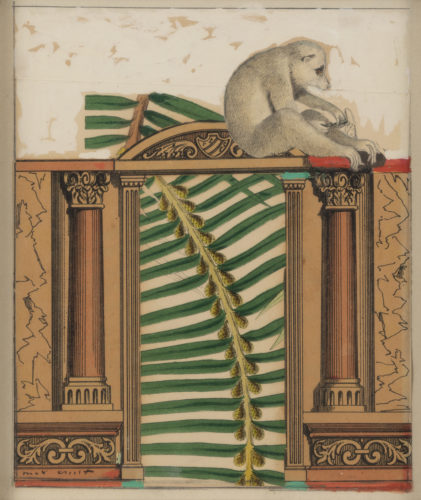Paul Kasmin Gallery is presenting a selection of forty collages by Max Ernst, a number of which are being shown publicly for the first time, emphasizes the innovative importance of the artist’s contribution to the genre, along with the recognition that collage was central to Ernst’s creativity from the start. Ernst, the only major Surrealist from Germany, used collage to juxtapose dazzlingly eccentric images, in ways that emphasized their visual novelty as well as suggesting narratives hard to grasp fully but wonderful to intimate. Ernst began making collages in 1919; the works on show date from 1920 to 1975, the year before he died. An entire wall of the gallery displays the artist’s lettrines: imagery swirling around a particular letter of the alphabet, the first letter of a chapter in a book (the practice dates to medieval times). Clearly, in this entertaining and even compelling exhibition, Ernst is a major practitioner of Surrealist magic, which leaned a good deal on Freud to make its raids on the unconscious. Sometimes, though the spell fails in Ernst’s art, and things can seem rather ordinary even when they present an extravagant vision. But at his best, Ernst in this show demonstrates he understood the intuitive associative processes of a certain kind of storytelling, in which the attempt to place coherence on widely differing elements fails in light of the composition’s involuntary connections.
Many of the works are compositionally complex–they tie together disparate elements in ways that would suggest a short story or fairytale. For example, in an untitled work from 1970s, an opossum or racoon is holding an unidentifiable tool in a frontal prehensile foot; it sits slightly to the right of an entablature supported by two columns, with a series of horizontal green fronds separating them. Elements of design–scroll-like elements resembling plants–are found on a half circle on top of the entablature, and at the base of the entire design. Just what exactly this is meant to say is elusive–we have no title to suggest a reading of the image. But maybe that’s the point; Ernst often deliberately made no sense, giving us a puzzle without an answer. The opossum in particular piques our curiosity, but it leaves no trace of a key to what it is doing. In contrast, Loplop présente (1931), a collage composed with graphite and ink, the image is much simpler visually, if also enigmatic to an extreme degree. It consists of the picture of a bird with one eye, its head and beak turned to the left. It holds an egg in each one of its claws. Another bird, its narrow head and pelican beak squeezed into a narrow space on the right, accompanies the main figure. We know that Loplop was an avian alternative self for Ernst, who created the creature close to the time of this image. Simple renderings of hands are place on the white sheet of paper serving as the background support for Loplop. The image is entertaining, even silly, but it underscores the richness of Ernst’s imagination.
A more colorful collage, made in 1969, consists of a nearly naked man with a beard holding a club in one hand and, in the other, the hand of his fully naked female companion, who rests a red vase on her shoulder. They stand in a brightly colored sylvan scene, complete with grass and, behind them, a large boulder and flowers. To the right is s a bare trunk of a tree, with a very large oriole, colored variously, perching on the limb that extends toward the left. Above the limb a single oversized white feather drifts in the air. The picture must be a vision of a natural paradise, damaged perhaps by violence (the club) and culture (the vase); moreover, the couple is fallen–or at least the man is, with a loincloth covering his genitals. This is one of Ernst’s easier compositions to read. An even more complex, colorful collage from 1972 shows on either side of the middle image of a meat-eating plant (looking a lot like a toothed vagina) images that seem to come from French advertisements of an earlier time–women dance or seem to exclaim while holding a bottle of wine. Beneath these images is a railway schedule on the left, and an entire group of the carnivorous plants, portrayed like vulvas standing next to each other. And beneath the central plant is a spider–another image of a creature given to capture. The combination of violence, sex, and simple fun is somehow moving, made more so by the luggage bags in muted colors at the bottom of the collage. Ernst’s symbolism was highly psychological, and more than a little carnal, so it is fair to note that he was the child of very strict Catholic parents. But , given the erotic spirit of Surrealism, it is important not to overemphasize Ernst’s biography.
The lettrines on view are of interest but limited in scope. One, of an N (1974), shows a bearded man in old-fashioned formal clothing playing a slender flute; to his right, slender metal tubes, perhaps flutes, act as a background to an image hard to describe–it looks like a compilation of body parts: buttocks, knees or thighs. The visual situation is absurd in the extreme; the formal attire and archaic look of the man’s grooming seem destined for an irrational giggle. But, as happens often in this show, it is hard to say what the image means. Generally speaking, the works use odd juxtapositions as if they made fully rational sense, but of course that isn’t true. That’s the point, though, of the Surrealist collage: the compiling of oddities intended to disturb the undercurrents of our thinking. Ernst belongs to a small group of modernists, Joan Miró among them, who made abstruse speculation popular. If Ernst was, at times, a bit illustrational or nonsensical, it is not his fault. His work belongs to a time that leaned sideways, toward the truly absurd.
